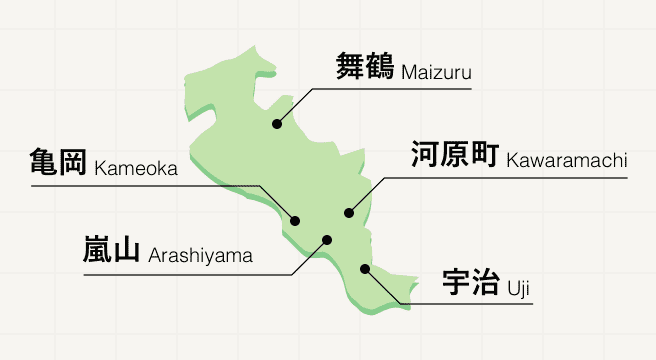Shrine Spots in Joyo / Yawata Area
Area
-
-
Kyoto
-
-
Kyoto
-
-
Joyo / Yawata
-
- All areas
- Around Gion
- Around Kiyomizu-Dera Temple
- Around Okazaki
- Around Ginkaku-Ji Temple
- Ichijo-ji Temple / Shugakuin
- Around Fushimi Inari
- Around Kyoto Station
- City Center
- Around Kyoto Imperial Palace
- Around Nishijin
- Around Kamigamo
- Around Kinkaku-Ji Temple
- Uzumasa / Hanazono
- Arashiyama / Sagano / Takao
- Around Mt. Hiei
- Ohara / Kurama / Kifune
- Katsura / Nishiyama
- Yamashina / Daigo
- Around Fushimi
- Around Uji
- Joyo / Yawata
- Kyotanabe / Kizugawa
- Kameoka / Nantan
- Maizuru / Miyazu
-
Joyo / Yawata

Category


-
- Iwashimizu-Hachimangu Shrine
-
4.5220 Reviews
- Travel / Tourism
- Kyoto Yawatashi Yawata Takabou 30
- Considered one of the greatest Hachiman shrines, Shinto shrines dedicated to Hachiman, in the country, this shrine was established in 859 when the deity of Usa Hachimangu in Kyushu was ceremonially divided and transferred here to protect an Imperial castle built in southwestern Heian-kyo (the former name of the city of Kyoto), considered an unlucky area due to the tenets of feng shui. Today, believers come to the shrine for protection from evil and calamity, and has come to be affectionately known as “Yawata no Hachiman-sama.” The Shrine’s vermillion-lacquered main building was rebuilt with donations from Tokugawa Iemitsu in the Edo period, and it, together with structures such as the inner shrine, outer shrine, two tier gate, are all registered as Important Cultural Property.
-
The main building is designated as a National Treasure a couple of years ago. This is the home of Hachiman shrines which spreads all over Japan. I bought a good luck charm years ago and it was so...
-
- Hiko-jinja Shrine
- Travel / Tourism
- Kyoto Yawatashi Yawata Doi 44
- "A Shinto shrine located a five-minute walk from Keihan Electric Railway Yawatashi Station. The shrine has three ""main"" shrine buildings. The center one is dedicated to Nigihayahi-no-Mikoto; the left one is dedicated to Yakusojin, Konpira, and Hakuryujin; and the right one is dedicated to all those who have participated in and those who died due to aerial bombing. The shrine was established in 1915 by aircraft designer Chuhachi Ninomiya to pray for the peace of those who died due to aviation, and pray for aerial safety and the development of the aerial industry. The shrine's priests also travel to hold purification ceremonies for newly built aircraft and helicopters, and ceremonies to give thanks to aircraft which have been destroyed or will no longer be used."
-
- Mito Shrine
-
4.013 Reviews
- Travel / Tourism
- Kyoto Joyo-shi Terada Miyanotani 29-1
-
JR城陽駅から徒歩20分位、なだらかな坂が続きますので結構疲れます。一の鳥居がJR線を挟んで反対側に有るので、往時は大変広かったと想像できます。奈良時代にはすでに存在していたと考えられる歴史ある神社、現在でも参拝者が多いようです。
-
- Sarumaru Shrine
-
3.58 Reviews
- Travel / Tourism
- Kyoto Tsuzuki-gun Ujitawaracho
-
三十六歌仙の一人、猿丸大夫を祀る神社。猿丸大夫との関係性は不明ながら、瘤取り・癌封じのご利益があるとされる。猿丸大夫の詠歌に因んでか多くの紅葉が植樹されており、紅葉の時期には名所になるであろうことが想像される。表参道は傾斜の急な石段なので、雨天時等は素直に裏参道から行った方が正解かもしれない。 毎月十三日は臨時バス便があるらしいが、それ以外の日はアクセスがかなり悪く、車がベスト。禅定寺から歩ける距...
-
- Arami Shrine
-
4.05 Reviews
- Travel / Tourism
- Kyoto Joyo-shi Tono Arami Da 165
-
薬医門の菊の紋は不思議だなと。桃山時代の慶長9年(1604)建築の本殿、蟇股の彫刻にも菊があります。境内社の御霊社は京都府登録文化財です。こじんまりとした神社ですが、素敵ですね。
-
- WakamiyaHachimangu Shrine
- Travel / Tourism
- Kyoto Kuse-gun Kumiyamacho Sako Uchi Yashiki 25-ban no 1
-
- Tokiwa Shrine
- Travel / Tourism
- Kyoto Kuse-gun Kumiyamacho Nomura Nomura 1
-
- Tamajo Shrine
- Travel / Tourism
- Kyoto Kusegunkumiyamachou Ichida Tamaki 1 - 2
-
- Arami Shrine
- Travel / Tourism
- Kyoto Kuse-gun Kumiyamacho Tai Arami 49
-
- Sokuri Shrine Shamusho
- Travel / Tourism
- Kyoto Kusegunkumiyamachou Sayama Saguri 55
-
- Ishida Shrine
- Travel / Tourism
- Kyoto Yawata-shi Kozuyasatogaito 77
-
- Yawata Shrine
- Travel / Tourism
- Kyoto Yawata-shi Tozukitashoji 124
-
- Miso Shrine
- Travel / Tourism
- Kyoto Yawata-shi
-
- Ishida Shrine
- Travel / Tourism
- Kyoto Yawata-shi Iwata Sato 35
-
- Tenmangu Shrine
- Travel / Tourism
- Kyoto Yawata-shi Kawaguchi Horinouchi 152-ban
-
- Wake Shrine
- Travel / Tourism
- Kyoto Yawata-shi Nishiyamawaki 1-4
-
- Kasuga Shrine
- Travel / Tourism
- Kyoto Yawata-shi Yawatanishijima 1
-
- Tenmangu Shrine
- Travel / Tourism
- Kyoto Yawata-shi Shimonaraokugaito 46-ban
-
- Uchi Shrine
- Travel / Tourism
- Kyoto Yawata-shi Uchizatouchi 1
-
- Kuse Shrine
- Travel / Tourism
- Kyoto Joyo-shi
Kyoto Areas

Its wooden tea houses, shuffling geisha, and spiritual sights have seen Kyoto hailed as the heart of traditional Japan, a world apart from ultramodern Tokyo. Despite being the Japanese capital for over a century, Kyoto escaped destruction during World War II, leaving behind a fascinating history which can be felt at every turn, from the fully gold-plated Kinkakuji Temple down to traditional customs such as geisha performances and tea ceremonies, which are still practiced to this day.
Best of Kyoto
Search by Region
-
- Hokkaido / Tohoku
- Hokkaido
- Aomori
- Iwate
- Miyagi
- Akita
- Yamagata
- Fukushima
-
- Kanto
- Ibaraki
- Tochigi
- Gunma
- Saitama
- Chiba
- Tokyo
- Kanagawa
-
- Koshinetsu / Hokuriku
- Niigata
- Toyama
- Ishikawa
- Fukui
- Yamanashi
- Nagano
-
- Tokai
- Gifu
- Shizuoka
- Aichi
- Mie
-
- Kinki
- Shiga
- Kyoto
- Osaka
- Hyogo
- Nara
- Wakayama
-
- Chugoku
- Tottori
- Shimane
- Okayama
- Hiroshima
- Yamaguchi
-
- Shikoku
- Tokushima
- Kagawa
- Ehime
- Kochi
-
- Kyushu / Okinawa
- Fukuoka
- Saga
- Nagasaki
- Kumamoto
- Oita
- Miyazaki
- Kagoshima
- Okinawa
















